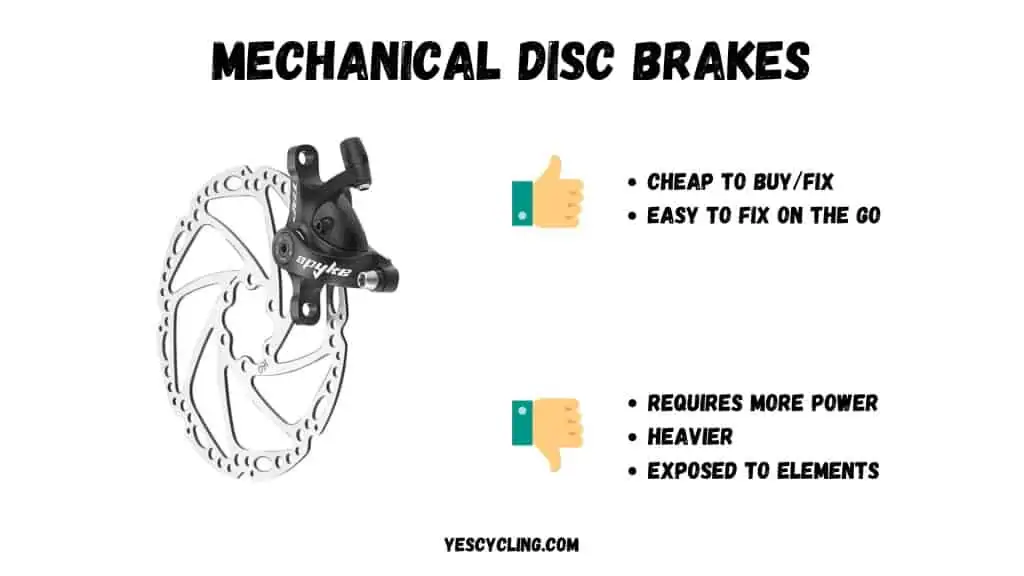Hydraulic vs. Mechanical Disc Brakes: What Are the Differences?

Today we’re going to dive into the world of disc brakes and explore the differences between hydraulic and mechanical systems. Whether you’re a seasoned pro or a first-time bike buyer, this post will give you the information you need to decide on the best brakes for your ride. So, let’s get started and find out which type of disc brakes will give you the stopping power and control you need to ride confidently.
Hydraulic vs. Mechanical Disc Brakes: Which is better?
While every brake on the market operates by a universal principle, differences arise in how they run: Fluid enables the brake pads to interact with the rotor, bringing the bike to a stop if those brakes are hydraulics. Mechanical disc brakes rely upon the cable to pull the bike’s caliper down. This forces the pads against the rotor to enable the stop.

Because hydraulic brake systems are fully enclosed, they’re not exposed to the elements, which means they may last longer. Hydraulic brakes require less effort to stop; it only takes a finger on the brake lever to complete the process. Hydraulics are self-adjusting, so braking tends to be smoother.
It is harder and more expensive to fix hydraulic braking systems, and upkeep tends to be messier and more complex. Maintenance of mechanical brakes tends to be easier and faster than more complicated hydraulic systems. If you break down on the fly, it may only take an Allen key to handle the fix.

Since mechanical brakes are constantly exposed to the elements and subject to more friction, breakdowns tend to happen more often — especially since cable stretching remains one of this brake type’s biggest dilemmas.
Performance differences
Mechanical brakes are heavier, while hydraulics are lighter and more resilient. The first requires more power and force to bring the ride to a halt, while hydraulics are considered more sensitive. Thus, not as much pressure is needed to engage the brake and stop the bike.
Maintenance differences
When compared, hydraulic brakes will always be less demanding than mechanical ones as long as you bleed your bike annually based on the miles you ride each year. But upkeep can lead to frustration. Make a few wrong moves when working on hydraulics. You risk ruining your rotors and brake pads.
Professionals recommend using a mechanic’s services to undertake repairs on bikes with hydraulics, but that doesn’t mean that mechanical disc brakes are a breeze to service. Mechanical brakes require more frequent servicing even though the job is relatively easy and fast. Mess up on tweaks and adjustments on your mechanical brakes, which could impair brake pad performance.
There are no differences in aligning the front and rear hydraulic disc brakes. Mechanical brake jobs require correct positioning and aligning of the rotor if it is to function correctly. Since mechanical brakes have fewer pins, expect more frequent realignments than you would on hydraulic components fabricated with more pins.
Price differences
Hydraulic disc brakes with integrated shifters (on drop-bar bikes) are pretty expensive,” one expert insists. Another says, “Cheap hydraulics cost no more than mechanical brakes but add perceived value. A bike with Hydraulics commanding a higher price has little to do with the cost of the brakes.”
Given these unique viewpoints, the question, “why are hydraulic brakes so much more expensive?” continues to drive conversations. One reason is that mechanical disc brake parts are easier to come by, and cables remain cheap and plentiful. But the perceived value of owning a bike with hydraulics can’t be dismissed.
Hydraulic disc brake systems range between $100 and $400 per set, the highest-end cost going to pre-bled and ready-to-install and use hydraulics. These prices include all components necessary for installation of either type. A low-end disc brake set-up can cost as little as $35, while you’ll spend around $150 for a mid-range kit.
Bottom Line
Mechanical disc brakes use a cable to pull the brake caliper, which squeezes the brake pads onto the rotor. They are simpler, easier to maintain, and compatible with standard brake levers, but require frequent adjustments as cables stretch over time.
Hydraulic disc brakes use fluid in a sealed system to transfer force from the lever to the caliper. This provides stronger, more consistent braking with less hand effort and self-adjusting pads for reduced maintenance. However, they are more complex, requiring occasional bleeding to remove air bubbles and specialized tools for repairs.
Hydraulic brakes are generally preferred for high-performance riding due to their superior stopping power and modulation, while mechanical brakes are a cost-effective, easier-to-service option for commuters and casual riders.






